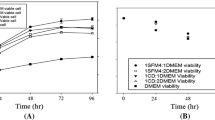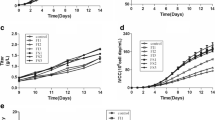Abstract
Anti PSA monoclonal antibodies for diagnostic use were produced in an in vitro system. After purification using Protein G affinity chromatography a percentage of about 10% of antibody aggregates remained. The use of monoclonal antibodies containing aggregates as a capture antibody in a diagnostic kit reduces the performance of the test making it often unacceptable. The aggregates could be eliminated using gel filtration chromatography but, in that way, the final recovery of the whole production process was only about 50%. Aggregation is favoured when the working pH is near to the isoelectric point of the antibody. We varied the culture medium composition, modifying pH and osmolarity. We tested different values of pH and osmolarity: 7.1, 7.5, 8.0, 8.5 for pH, and 300, 340, 367, 395 mOsm/kg H2O for osmolarity. By modification of the cell culture medium we obtained a significant decrease of monoclonal antibody aggregates in the production cycle. In this way we achieved higher recovery rate and could avoid gel filtration polishing step. The experiments were performed in two stages: first in culture flasks changing one parameter in each experiment, and then in spinner bottle using the best conditions obtained in the first stage. During scale up we used the modifications achieved from the experiment showed in this paper in our production by hollow fibre bioreactor with positive results.
Similar content being viewed by others
References
Akerstrom B, Brodin T, Reis K and Bjorck L (1985) Protein G: a powerful tool for binding and detection of monoclonal and policlonal antibodies. J Immunol 135: 2589.
Bibila TA, Ranucci CS, Glazomitsk, K, Buckland BC and Aunins JG (1994) Monoclonal Antibody Process Development using Medium Concentrates. Biotechnol Prog 10: 87.
Cooper EH, Turner R, Johns EA and Crockson RA (1985) Identification and measurement of paraprotein polymers by high performance gel filtration chromatography. Biomed Pharmacother 39: 78.
Guse AH et al. (1994) Purification and characterization of an anti-CD4 monoclonal antibody for human therapy. J Chrom 661: 12.
Guss B, Eliasson M, Olsson A, Uhlen M, Frei AK, Jornvallm, Flock JI and Lindberg M (1986) Structure of the IgG — binding regions of streptococcal protein G. EMBO J 5: 1567.
Hangel L (1993) Size-exclusion chromatography in an analytical perspective. J Chromatogr 648: 19.
Harlow E and Lane D (1988) Antibodies — A Laboratory Manual, Cold Spring Harbour Laboratory, p. 673.
Klein J (1982) Immunology — The Science of Self-Nonself Discrimination, John Wiley & Sons Inc., p. 245.
Kromenaker SJ and Srienc F. (1994) Effect of lactic acid on the kinetics of growth and antibody production in a murine hybridoma: secretion patterns during the cell cycle. J Biotechnol 34(1): 13.
Øyaas K, Berg TM, Bakke O and Levine DW (1989) Hybridoma growth and antibody production under conditions of hyperosmotic stress, In: Spier, RE, Griffiths, JB, Stephenne, J and Crooy PJ (eds) Advances in Animal Cell Biology and Technology for Bioprocesses, pp. 272-278, Butterworths, Sevenoaks, U.K.
Ozturk SS and Palsson BO (1991) Effect of medium osmolarity on hybridoma growth, metabolism and antibody production. Biotechnol Bioeng 37, 989.
Reuveny S, Velez D, Macmillan JD and Miller L (1986) Factors affecting cell growth and monoclonal antibody production in stirred reactors. J Immunol Methods 86: 53.
Scopes KR (1987) Protein Purification — Principles and Practice, p. 42-44.
Sridhar R, Bauer Kenneth D and Miller WM (1992) Determination of antibody content in live versus dead hybridoma cells: Analysis of antibody production in osmotically stressed culture. Biotechnol and Bioen 40: 947.
Author information
Authors and Affiliations
Rights and permissions
About this article
Cite this article
Franco, R., Daniela, G., Fabrizio, M. et al. Influence of osmolarity and pH increase to achieve a reduction of monoclonal antibodies aggregates in a production process. Cytotechnology 29, 11–25 (1999). https://doi.org/10.1023/A:1008075423609
Issue Date:
DOI: https://doi.org/10.1023/A:1008075423609




